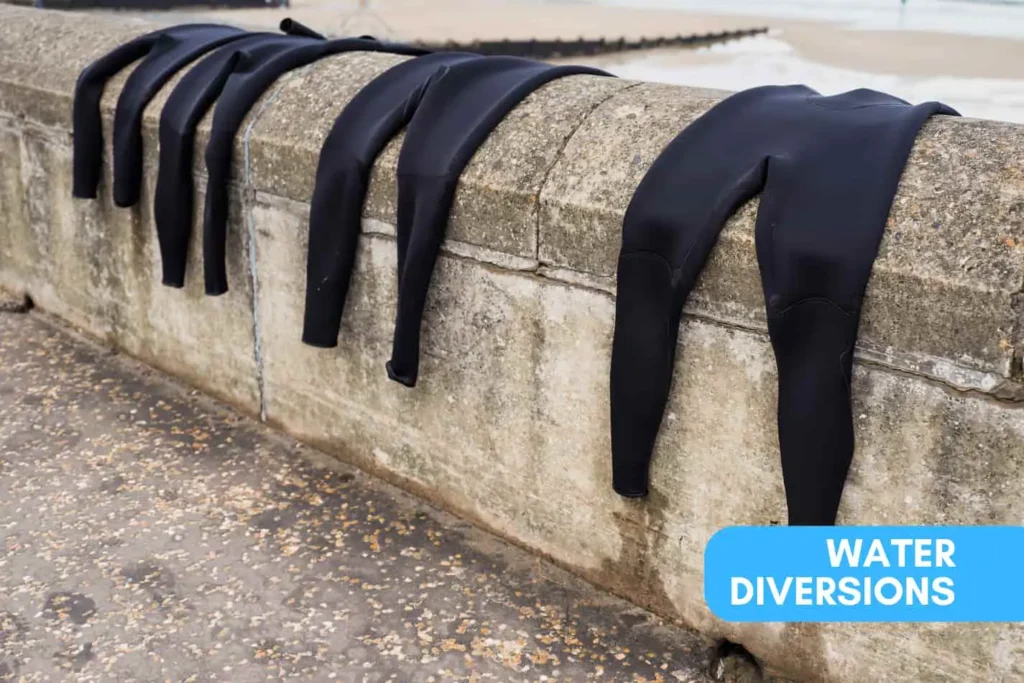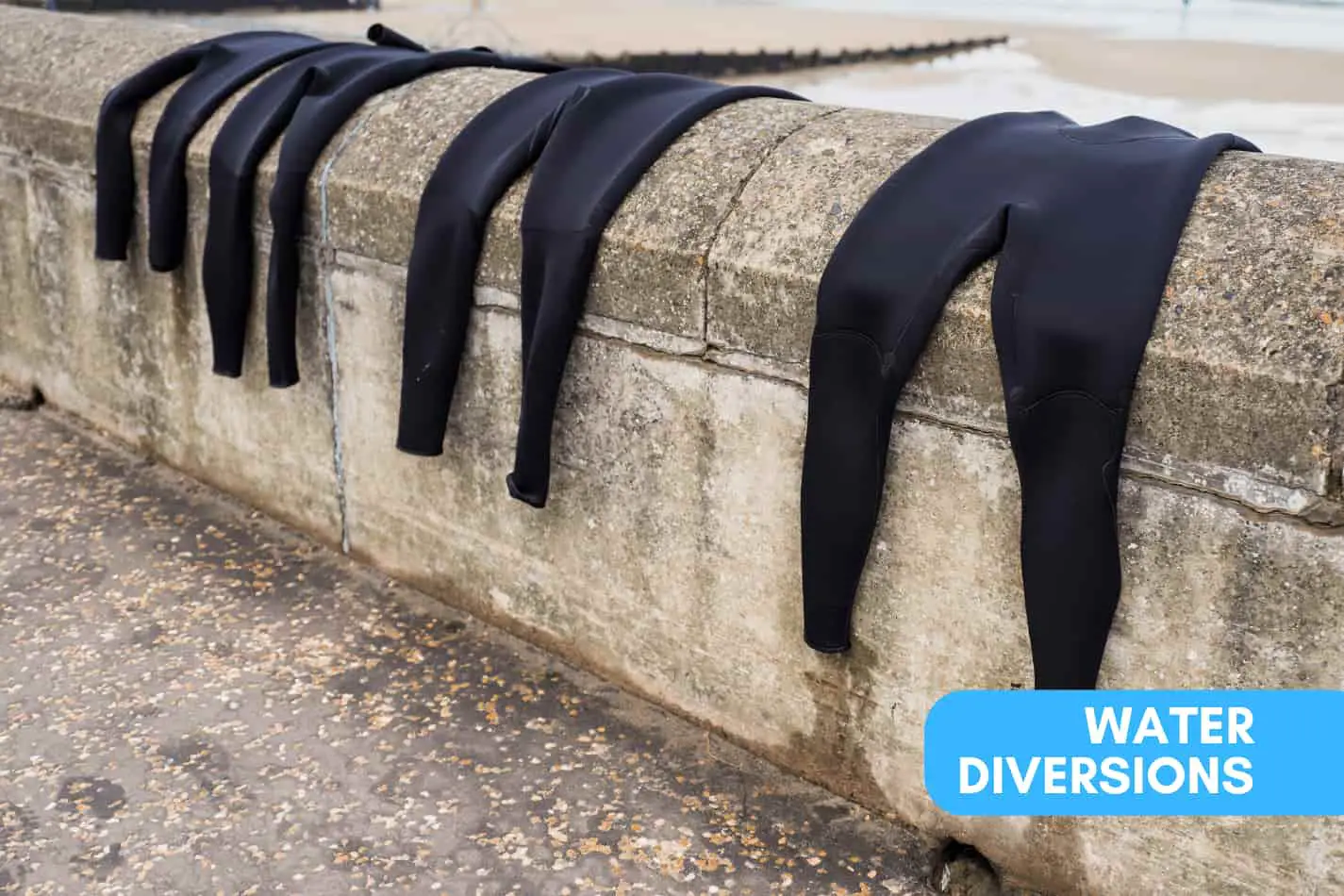Are you a diver planning to try your hand at surfing, or vice versa? Knowing what type of wetsuit to buy for your water-based adventure is important.
This blog post will explore the similarities and differences between diving and surfing wetsuits so you can make an informed decision.

What are Surfing and Diving Wetsuits?
Surfing and diving wetsuits are specialized equipment designed with the respective water sports in mind.
Surfing wetsuits are made from neoprene, a lightweight, flexible material that allows for more movement than a traditional scuba diving suit.
These suits come in different thicknesses and sizes, designed to keep the surfer warm and comfortable while out on the waves.
Scuba diving wetsuits, on the other hand, are thicker and less flexible due to the extreme pressure from being underwater.
They are usually made from compression-resistant neoprene that is designed to protect divers from cold water temperatures and pressurized depths.
Both types of wetsuits have their own benefits, depending on the activity you plan to do.
Differences in Design
The design of surfing and diving wetsuits differs in a few key ways.
Surfing wetsuits are cut to allow more movement and flexibility in the arms and legs, while diving wetsuits are tailored to meet the specific needs of the sport.
Surfing wetsuits often come with pockets, while diving wetsuits generally don’t.
Additionally, surfing wetsuits tend to be thinner than diving wetsuits as they don’t need to provide as much insulation from the colder water temperatures of scuba diving.
All these differences make each type of wetsuit perfect for its own purpose.
Differences in Thickness
The biggest difference between a scuba diving and a surfing wetsuit is the thickness.
Scuba diving wetsuits are usually thicker and denser than surfing wetsuits due to the increased pressure at depth.
This makes them stiffer and less flexible and provides excellent protection from the cold.
Surfing wetsuits are thinner and more flexible, which allows for greater mobility in the water.
Diving suits are available in different thicknesses, such as 3mm, 5mm, and 7mm, mainly to adapt to the temperature of other regions.
Therefore, the thickness of a wetsuit should be chosen based on the activity and climate for optimal performance.
Purpose of Each Type of Wetsuit
The purpose of each type of wetsuit is as varied as the activities they are used for.
Diving wetsuits primarily serve to protect against the cold and keep divers warm under extreme conditions.
Scuba-specific wetsuits are designed with thicker neoprene to resist compression and provide superior warmth.
Surfing wetsuits are designed with flexibility, allowing surfers to move freely while staying warm and protected from the sun.
In addition, surfing wetsuits provide buoyancy when needed, helping to keep surfers afloat.
Freediving and spearfishing wetsuits are designed for maximum comfort and flexibility, enabling divers to move quickly through the water in search of their prey.
Each type of wetsuit provides unique benefits that make them ideal for their intended purpose.
Diving Wetsuits
Diving wetsuits offer an extra layer of protection for scuba divers as they are designed for the extreme pressure experienced underwater.
They are typically made from a thicker and tougher neoprene material that is more buoyant than a surfing wetsuit and offers excellent insulation from the cold.
Diving wetsuits also have a higher-grade sealant around the seams to prevent water from entering and better-engineered fabric that offers superior resistance to abrasion and tears.
For less-skilled divers, or those diving in colder waters, a scuba wetsuit is often the best choice due to its superior protection and insulation.
Surfing Wetsuits
Surfing wetsuits are designed with flexibility in mind. They are made from neoprene and designed to provide freedom of movement while in the water.
A surfing wetsuit typically has more panels and seams than a scuba wetsuit to ensure a snug fit and provide a greater range of motion.
The neoprene also adds buoyancy, allowing surfers to stay afloat longer.
The thinner material of a surfing wetsuit generally provides less protection from the cold than its scuba counterpart, but it does an admirable job of keeping its wearer warm.
Surfing Wetsuits vs Scuba Suits
Surfing wetsuits and scuba diving wetsuits are designed to serve different purposes and have different features.
The main difference between a surfing wetsuit and a scuba diving wetsuit is the thickness.
Scuba diving wetsuits can be 3, 5, 7, or even 9 mm thick, as underwater pressure requires thicker neoprene for protection.
On the other hand, surfing wetsuits are often less than 2 mm thick, primarily used to keep riders warm while on the surface.
It should also be noted that while both types of wetsuits can be used in various temperatures, scuba diving wetsuits are better suited for colder waters due to their increased insulation.
Finally, while some surf brands offer scuba suits, they should not be confused with traditional surfing wetsuits as they are heavier and less flexible, making them more suitable for deep-sea exploration.
Do Surf Brands Make Scuba Suits?
Surf brands generally do not make scuba suits, as they are designed for different purposes.
Surf wetsuits are typically much thinner than scuba suits and have less compression-resistant neoprene.
This provides greater flexibility and mobility for surfers in the water.
Scuba diving suits, on the other hand, are designed to be more durable and offer better insulation against cold ocean waters.
As such, it is essential to note that a surfing wetsuit will not be suitable for scuba diving, and vice versa.
Surfing Wetsuits and Movement
Surfing wetsuits are designed to be more flexible than scuba diving wetsuits, allowing surfers to move their arms and legs with greater ease.
This is especially important when maneuvering the board and performing tricks. It also helps to reduce fatigue, which is essential when riding waves for extended periods.
The suit’s flexibility also ensures that the material won’t get in the way of a surfer’s movements, allowing them to feel comfortable and unrestricted while in the water.
Temperature Regulation in Water
Whether you’re surfing or scuba diving, the temperature of the water you’ll be in will play a role in the type of wetsuit, you’ll need.
Wetsuits are designed to keep you warm by trapping a thin layer of water between your skin and the neoprene material.
This thin layer of water is then heated by your body temperature, creating insulation and warmth.
A 4/3mm wetsuit is usually recommended for surfing in cooler temperatures as it provides good insulation and flexibility.
However, when scuba diving, a thicker suit is needed to provide sufficient insulation at depth under compression.
A full scuba suit is designed to provide superior protection and warmth when diving in colder waters.
Additionally, wearing a wetsuit can provide extra protection against the environment, such as coral or other sharp objects.
Overall, wetsuits are designed to help regulate body temperature while in the water, no matter your activity.
The Benefits of Each Type of Wetsuit
The benefits of each wetsuit are vast. Diving wetsuits are designed to keep the wearer warm and comfortable in colder depths while surfing wetsuits protect from the elements and improve performance in the waves.
Scuba divers benefit from extra warmth and buoyancy from their thicker suits, while surfers gain greater flexibility and agility from their thinner suits.
Both types of wetsuits are incredibly durable, providing long-lasting protection for their owners.
Additionally, diving and surfing wetsuits offer excellent temperature regulation for those spending extended periods in the water.
With so many different options available, there’s sure to be a wetsuit that can suit your individual needs.
Conclusion
In conclusion, there are significant differences between diving and surfing wetsuits.
Surfing wetsuits are designed to be lighter and more flexible to allow for greater freedom of movement while in the water.
On the other hand, diving wetsuits are thicker and designed to resist water pressure. They also offer excellent thermal protection for cold-water dives.
Finally, surf brands generally do not make scuba wetsuits as they have different needs.
No matter which type of wetsuit you choose, it is crucial to find one that fits well and provides the necessary protection for your specific activity.

